
The Climate Change Pact agreed by leaders at the end of COP26 in Glasgow went further than many pessimists had forecast, but not far enough to meet the goal of keeping global warming to 1.5°C above pre-industrial levels. The Pact states that:
limiting global warming to 1.5°C requires rapid, deep and sustained reductions in global greenhouse gas emissions, including reducing global carbon dioxide emissions by 45 per cent by 2030 relative to the 2010 level and to net zero around mid-century, as well as deep reductions in other greenhouse gases.
So how far would the commitments made in Glasgow restrict global warming and what actions need to be put in place to meet these commitments?
Short-term commitments and long-term goals
According to Climate Action Tracker, the short-term commitments to action that countries set out would cause global warming of 2.4°C by the end of the century, the effects of which would be calamitous in terms of rising sea levels and extreme weather.
However, long-term commitments to goals, as opposed to specific actions, if turned into specific actions to meet the goals would restrict warming to around 1.8°C by the end of the century. These long-term goals include reaching net zero emissions by certain dates. For the majority of the 136 countries agreeing to reach net zero, the date they set was 2050, but for some developing countries, it was later. China, Brazil, Indonesia, Russia, Nigeria, Sri Lanka and Saudi Arabia, for example, set a date of 2060 and India of 2070. Some countries set an earlier target and others, such as Benin, Bhutan, Cambodia, Guyana, Liberia and Madagascar, claimed they had already reached zero net emissions.
Despite these target dates, Climate Action Tracker argues that only 6 per cent of countries pledging net zero have robust policies in place to meet the targets. The problem is that actions are required by firms and individuals. They must cut their direct emissions and reduce the consumption of products whose production involved emissions.
 Governments can incentivise individuals and firms through emissions and product taxes, through carbon pricing, through cap-and-trade schemes, through subsidies on green investment, production and consumption, through legal limits on emissions, through trying to change behaviour by education campaigns, and so on. In each case, the extent to which individuals and firms will respond is hard to predict. People may want to reduce global warming and yet be reluctant to change their own behaviour, seeing themselves as too insignificant to make any difference and blaming big business, governments or rich individuals. It is important, therefore, for governments to get incentive mechanisms right to achieve the stated targets.
Governments can incentivise individuals and firms through emissions and product taxes, through carbon pricing, through cap-and-trade schemes, through subsidies on green investment, production and consumption, through legal limits on emissions, through trying to change behaviour by education campaigns, and so on. In each case, the extent to which individuals and firms will respond is hard to predict. People may want to reduce global warming and yet be reluctant to change their own behaviour, seeing themselves as too insignificant to make any difference and blaming big business, governments or rich individuals. It is important, therefore, for governments to get incentive mechanisms right to achieve the stated targets.
Let us turn to some specific targets specified in the Climate Change Pact.
Phasing out fossil fuel subsidies
Paragraph 20 of the Climate Change Pact
Calls upon Parties to accelerate … efforts towards the … phase-out of inefficient fossil fuel subsidies, while providing targeted support to the poorest and most vulnerable in line with national circumstances and recognizing the need for support towards a just transition.
Production subsidies include tax breaks or direct payments that reduce the cost of producing coal, oil or gas. Consumption subsidies cut fuel prices for the end user, such as by fixing the price at the petrol pump below the market rate. They are often justified as a way of making energy cheaper for poorer people. In fact, they provide a bigger benefit to wealthier people, who are larger users of energy. A more efficient way of helping the poor would be through benefits or general tax relief. Removing consumption subsidies in 32 countries alone would, according to International Institute for Sustainable Development, cut greenhouse gas emission by an average of 6 per cent by 2025.
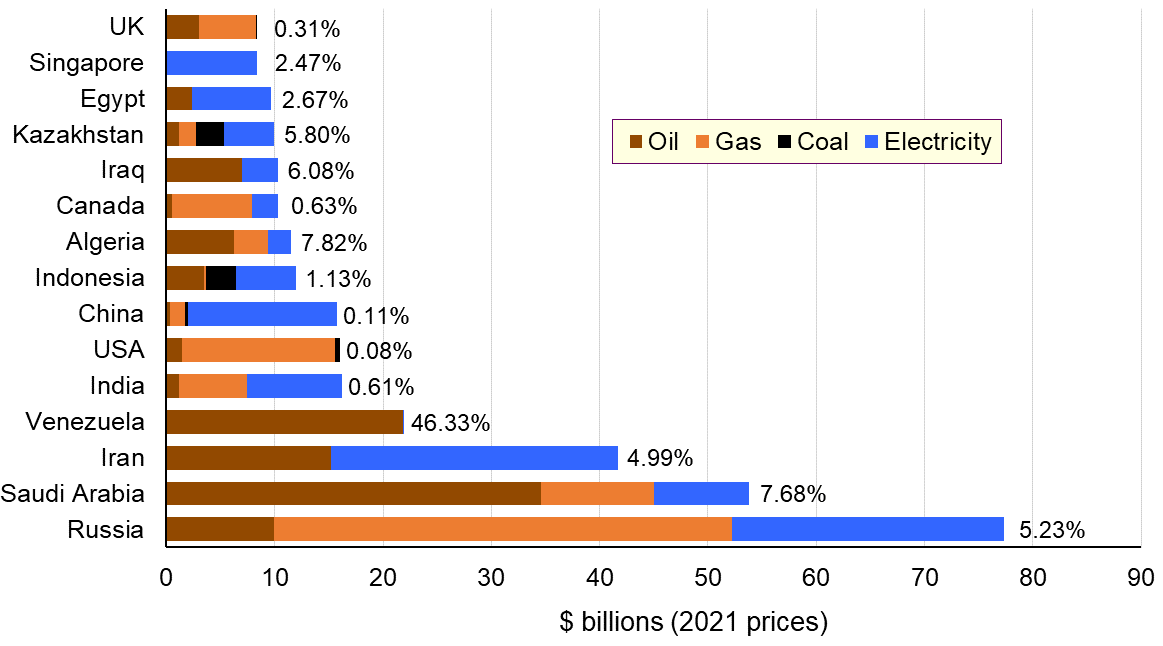 The chart shows the 15 countries providing the largest amount of support to fossil fuel industries in 2020 (in 2021 prices). The bars are in billions of dollars and the percentage of GDP is also given for each country. Subsidies include both production and consumption subsidies. (Click here for a PowerPoint of the chart.) In addition to the direct subsidies shown in the chart, there are the indirect costs of subsidies, including pollution, environmental destruction and the impact on the climate. According to the IMF, these amounted to $5.4 trillion in 2020.
The chart shows the 15 countries providing the largest amount of support to fossil fuel industries in 2020 (in 2021 prices). The bars are in billions of dollars and the percentage of GDP is also given for each country. Subsidies include both production and consumption subsidies. (Click here for a PowerPoint of the chart.) In addition to the direct subsidies shown in the chart, there are the indirect costs of subsidies, including pollution, environmental destruction and the impact on the climate. According to the IMF, these amounted to $5.4 trillion in 2020.
But getting countries to agree on a path to cutting subsidies, when conditions vary enormously from one country to another, proved very difficult.
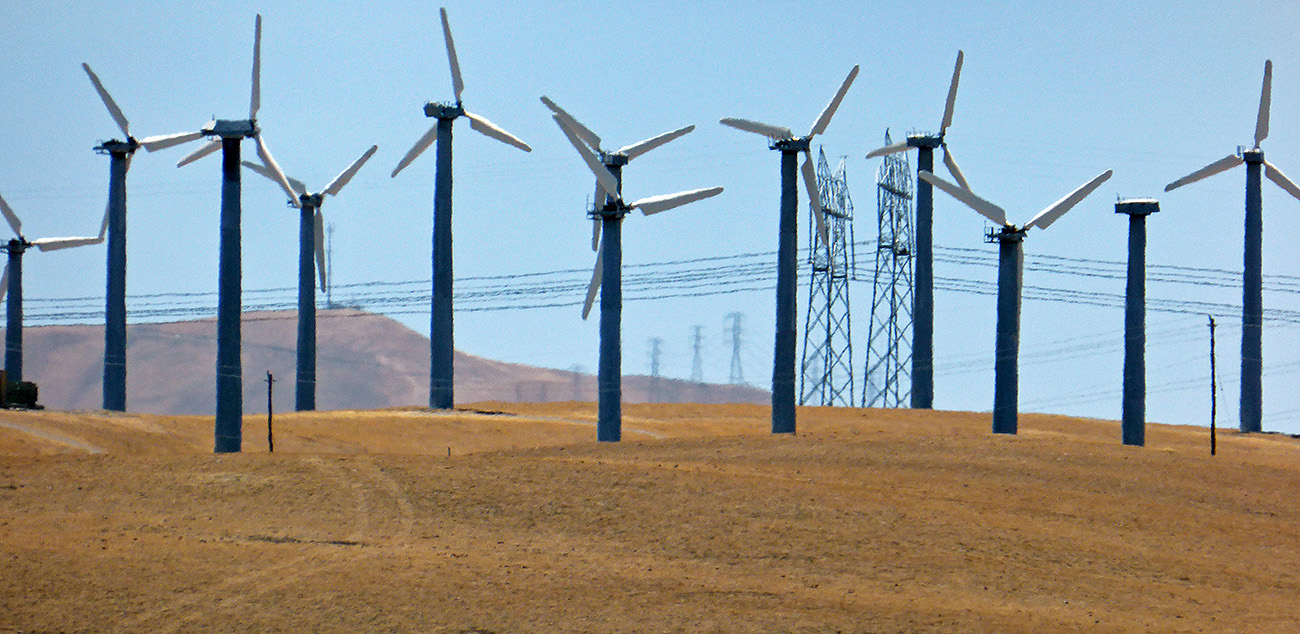 The first draft of the conference agreement called for countries to ‘to accelerate the phasing-out of coal and subsidies for fossil fuels’. But, after objections from major coal producing countries, such as China, India and Australia, this was weakened to calling on countries to accelerate the shift to clean energy systems ‘by scaling up the deployment of clean power generation and energy efficiency measures, including accelerating efforts towards the phasedown of unabated coal power and phase-out of inefficient fossil fuel subsidies’. (‘Unabated’ coal power refers to power generation with no carbon capture.) Changing ‘phasing-out’ to ‘the phasedown’ caused consternation among many delegates who saw this as a substantial weakening of the drive to end the use of coal.
The first draft of the conference agreement called for countries to ‘to accelerate the phasing-out of coal and subsidies for fossil fuels’. But, after objections from major coal producing countries, such as China, India and Australia, this was weakened to calling on countries to accelerate the shift to clean energy systems ‘by scaling up the deployment of clean power generation and energy efficiency measures, including accelerating efforts towards the phasedown of unabated coal power and phase-out of inefficient fossil fuel subsidies’. (‘Unabated’ coal power refers to power generation with no carbon capture.) Changing ‘phasing-out’ to ‘the phasedown’ caused consternation among many delegates who saw this as a substantial weakening of the drive to end the use of coal.
Another problem is in defining ‘inefficient’ subsidies. Countries are likely to define them in a way that suits them.
The key question was the extent to which countries would actually adopt such measures and what the details would be. Would they be strong enough? This remained to be seen.
As an article in the journal, Nature, points out:
There are three main barriers to removing production subsidies … First, fossil-fuel companies are powerful political groups. Second, there are legitimate concerns about job losses in communities that have few alternative employment options. And third, people often worry that rising energy prices might depress economic growth or trigger inflation.
The other question with the phasing out of subsidies is how and how much would there be ‘targeted support to the poorest and most vulnerable in line with national circumstances’.
Financial support for developing countries
 Transitioning to a low-carbon economy and investing in measures to protect people from rising sea levels, floods, droughts, fires, etc. costs money. With many developing countries facing serious financial problems, especially in the light of measures to support their economies and healthcare systems to mitigate the effects of COVID-19, support is needed from the developed world.
Transitioning to a low-carbon economy and investing in measures to protect people from rising sea levels, floods, droughts, fires, etc. costs money. With many developing countries facing serious financial problems, especially in the light of measures to support their economies and healthcare systems to mitigate the effects of COVID-19, support is needed from the developed world.
In the COP21 Paris Agreement in 2015, developed countries pledged $100 billion by 2020 to support mitigation of and adaptation to the effects of climate change by developing countries. But the target was not reached. The COP26 Pact urged ‘developed country Parties to fully deliver on the $100 billion goal urgently and through to 2025’. It also emphasised the importance of transparency in the implementation of their pledges. The proposal was also discussed to set up a trillion dollar per year fund from 2025, but no agreement was reached.
It remains to be seen just how much support will be given.
Then there was the question of compensating developing countries for the loss and damage which has already resulted from climate change. Large historical polluters, such as the USA, the UK and various EU countries, were unwilling to agree to a compensation mechanism, fearing that any recognition of culpability could make them open to lawsuits and demands for financial compensation.
Other decisions
- More than 100 countries at the meeting agreed to cut global methane emissions by at least 30 per cent from 2020 levels by 2030. Methane is a more powerful but shorter-living greenhouse gas than carbon. It is responsible for about a third of all human-generated global warming. China, India and Russia, however, did not sign up.
 Again, more than 100 countries agreed to stop deforestation by 2030. These countries include Indonesia and Brazil, which has been heavily criticised for allowing large parts of the Amazon rainforest to be cleared for farming, such that the Amazon region in recent years has been a net emitter of carbon from the felling and burning of trees. The pledge has been met with considerable cynicism, however, as it unclear how it will be policed. Much of the deforestation around the world is already illegal but goes ahead anyway.
Again, more than 100 countries agreed to stop deforestation by 2030. These countries include Indonesia and Brazil, which has been heavily criticised for allowing large parts of the Amazon rainforest to be cleared for farming, such that the Amazon region in recent years has been a net emitter of carbon from the felling and burning of trees. The pledge has been met with considerable cynicism, however, as it unclear how it will be policed. Much of the deforestation around the world is already illegal but goes ahead anyway.- A mechanism for trading carbon credits was agreed. This allows countries which plant forests or build wind farms to earn credits. However, it may simply provide a mechanism for rich countries and businesses to keep emitting as usual by buying credits.
- Forty-five countries pledged to invest in green agricultural practices to make farming more sustainable.
- Twenty-two countries signed a declaration to create zero-emission maritime shipping routes.
- The USA and China signed a joint declaration promising to boost co-operation over the next decade on various climate actions, including reducing methane emissions, tackling deforestation and regulating decarbonisation.
 Blah, blah, blah or real action?
Blah, blah, blah or real action?
Many of the decisions merely represent targets. What is essential is for countries clearly to spell out the mechanisms they will use for achieving them. So far there is too little detail. It was agreed, therefore, to reconvene in a year’s time at COP27 in Egypt. Countries will be expected to spell out in detail what actions they are taking to meet their emissions targets and other targets such as ending deforestation and reducing coal-fired generation.
Articles
- COP26 ended with the Glasgow Climate Pact. Here’s where it succeeded and failed
CNN, Angela Dewan and Amy Cassidy (14/11/21)
- Good COP, Bad COP: Separating heat from light at the climate summit
Ing, Samuel Abettan, Gerben Hieminga and Coco Zhang (15/11/21)
- COP26: What was agreed at the Glasgow climate conference?
BBC News (15/11/21)
- Five Things You Need to Know About The New Glasgow Climate Pact
The Conversation, Simon Lewis and Mark Maslin (13/11/21)
- Infographic: What has your country pledged at COP26?
Aljazeera, Hanna Duggal (14/11/21)
- Cop26: world on track for disastrous heating of more than 2.4C, says key report
The Guardian, Fiona Harvey (9/11/21)
- Cop26 took us one step closer to combating the climate crisis
The Guardian, Christiana Figueres (15/11/21)
- After the failure of Cop26, there’s only one last hope for our survival
The Guardian, George Monbiot (14/11/21)
- Why fossil fuel subsidies are so hard to kill
Nature, Jocelyn Timperley (20/10/21)
- The COP26 blah blah blah detector
Rappler, Elpidio Peria (16/11/21)
Podcasts
Videos
Report
Document
Questions
- What were the main achievements of COP26?
- What were the main failings of COP26?
- How can people be incentivised to reduce their direct and indirect greenhouse gas emissions?
- How is game theory relevant to understanding the difficulties in achieving global net zero emissions?
- Should developing countries be required to give up coal power?
- If the world is to achieve net zero greenhouse gas emissions, should all countries achieve net zero or should some countries achieve net negative emissions to allow others to continue with net positive emissions (albeit at a lower level)?
 One of the major economic concerns about the COVID-19 pandemic has been the likely long-term scarring effects on economies from bankruptcies, a decline in investment, lower spending on research and development, a loss of skills, discouragement of workers, disruption to education, etc. The result would be a decline in potential output or, at best, a slower growth. These persistent effects are known as ‘hysteresis’ – an effect that persists after the original cause has disappeared.
One of the major economic concerns about the COVID-19 pandemic has been the likely long-term scarring effects on economies from bankruptcies, a decline in investment, lower spending on research and development, a loss of skills, discouragement of workers, disruption to education, etc. The result would be a decline in potential output or, at best, a slower growth. These persistent effects are known as ‘hysteresis’ – an effect that persists after the original cause has disappeared.
In a speech by Dave Ramsden, the Bank of England’s Deputy Governor for Markets & Banking, he argued that, according to MPC estimates, the pandemic will have caused a loss of potential output of 1.75%. This shortfall may seem small at first sight, so does it matter? According to Ramsden:
The answer is definitely yes for two reasons. First, a 1¾% shortfall as a share of annual GDP for the UK … represents roughly £39 billion – for context, that’s about half of the education budget. And second, that 1¾% represents a permanent shortfall, or at least a very persistent one, on top of the impact of the immediate downturn. If you lose 1¾% of GDP every year for ten years, then in total you have lost 17.5% of one year’s GDP, or around £390bn in 2019 terms
However, as the IMF blog linked below argues, there may be positive supply-side effects which outweigh these scarring effects, causing a net rise in potential GDP growth. There are two possible reasons for this.
 The first is that the pandemic may have hastened the process of digitalisation and automation. Examples include ‘video conferencing and file sharing applications to drones and data-mining technologies’. According to evidence from a sample of 15 countries cited in the blog, a 10% rise in such intangible capital investment is associated with about a 4½% rise in labour productivity. ‘As COVID-19 recedes, the firms which invested in intangible assets, such as digital technologies and patents may see higher productivity as a result.’
The first is that the pandemic may have hastened the process of digitalisation and automation. Examples include ‘video conferencing and file sharing applications to drones and data-mining technologies’. According to evidence from a sample of 15 countries cited in the blog, a 10% rise in such intangible capital investment is associated with about a 4½% rise in labour productivity. ‘As COVID-19 recedes, the firms which invested in intangible assets, such as digital technologies and patents may see higher productivity as a result.’
The second is a reallocation of workers and capital to more productive sectors. Firms in some sectors, such as leisure, hospitality and retail, have relatively low labour productivity. Many parts of these industries have declined during the pandemic, especially those with high labour intensity. At the same time, there has been a rise in employment in firms where output per worker is higher. Such sectors include e-commerce and those where remote working is possible. The greater the reallocation from low labour-productivity to high labour-productivity sectors, the more will overall labour productivity rise and hence the more will potential output increase.
The size of these two effects will depend to a large extent on expectations, incentives and government policy. The blog cites four types of policy that can help investment and reallocation.
- Improved insolvency and restructuring procedures to enable capital in failed firms to be reallocated to sectors with potential for growth.
- Promoting competition to enable the exit and entry of firms into expanding sectors and to prevent powerful firms from blocking the process.
- Refocusing policy from retaining labour in existing jobs to reskilling workers for new jobs, thereby improving labour mobility from declining to expanding sectors.
- Addressing financial bottlenecks, so as to ensure adequate access to financing for viable firms.
Whether there will be a net increase or decrease in productivity from the pandemic very much depends on the extent to which firms and workers are able and willing to take advantage of new opportunities and the extent to which government supports investment in and reallocation to high-productivity sectors.
Blogs, articles and speeches
Questions
- Can actual economic growth be greater than potential economic growth (a) in the short run; (b) in the long run?
- Give some example of scarring effects from the COVID-19 pandemic.
- What effects might short-term policies to tackle the recession caused by the pandemic have on longer-term potential economic growth?
- What practical policies could governments adopt to encourage the positive supply-side effects of the pandemic? To what extent would these policies have negative short-term effects?
- Why might (endogenous) financial crises result in larger and more persistent reductions in potential output than exogenous crises, such as a pandemic or a war?
- Distinguish between interventionist and market-orientated supply-side policies to encourage the reallocation of labour and capital to higher-productivity sectors.
 Many developing countries are facing a renewed debt crisis. This is directly related to Covid-19, which is now sweeping across many poor countries in a new wave.
Many developing countries are facing a renewed debt crisis. This is directly related to Covid-19, which is now sweeping across many poor countries in a new wave.
Between 2016 and 2020, debt service as a percentage of GDP rose from an average of 7.1% to 27.1% for South Asian countries, from 8.1% to 14.1% for Sub-Saharan African countries, from 13.1% to 42.3% for North African and Middle Eastern countries, and from 5.6% to 14.7% for East Asian and Pacific countries. These percentages are expected to climb again in 2021 by around 10% of GDP.
Incomes have fallen in developing countries with illness, lockdowns and business failures. This has been compounded by a fall in their exports as the world economy has contracted and by a 19% fall in aid in 2020. The fall in incomes has led to a decline in tax revenues and demands for increased government expenditure on healthcare and social support. Public-sector deficits have thus risen steeply.
And the problem is likely to get worse before it gets better. Vaccination roll-outs in most developing countries are slow, with only a tiny fraction of the population having received just one jab. With the economic damage already caused, growth is likely to be subdued for some time.
This has put developing countries in a ‘trilemma’, as the IMF calls it. Governments must balance the objectives of:
- meeting increased spending needs from the emergency and its aftermath;
- limiting the substantial increase in public debt;
- trying to contain rises in taxes.
Developing countries are faced with a difficult trade-off between these objectives, as addressing one objective is likely to come at the expense of the other two. For example, higher spending would require higher deficits and debt or higher taxes.
The poorest countries have little scope for increased domestic borrowing and have been forced to borrow on international markets. But such debt is costly. Although international interest rates are generally low, many developing countries have had to take on increasing levels of borrowing from private lenders at much higher rates of interest, substantially adding to the servicing costs of their debt.
Debt relief
 International agencies and groups, such as the IMF, the World Bank, the United Nations and the G20, have all advocated increased help to tackle this debt crisis. The IMF has allocated $100bn in lending through the Rapid Financing Instrument (RFI) and the Rapid Credit Facility (RCF) and nearly $500m in debt service relief grants through the Catastrophe Containment and Relief Trust (CCRT). The World Bank is increasing operations to $160bn.
International agencies and groups, such as the IMF, the World Bank, the United Nations and the G20, have all advocated increased help to tackle this debt crisis. The IMF has allocated $100bn in lending through the Rapid Financing Instrument (RFI) and the Rapid Credit Facility (RCF) and nearly $500m in debt service relief grants through the Catastrophe Containment and Relief Trust (CCRT). The World Bank is increasing operations to $160bn.
The IMF is also considering an increase in special drawing rights (SDRs) from the current level of 204.2bn ($293.3bn) to 452.6bn ($650bn) – a rise of 121.6%. This would be the first such expansion since 2009. It has received the support of both the G7 and the G20. SDRs are reserves created by the IMF whose value is a weighted average of five currencies – the US dollar (41.73%), the euro (30.93%), the Chinese yuan (10.92%), the Japanese yen (8.33%) and the pound sterling (8.09%).
Normally an increase in SDRs would be allocated to countries according their IMF quotas, which largely depend on the size of their GDP and their openness. Any new allocation under this formula would therefore go mainly to developed countries, with developing economies getting only around $60bn of the extra $357bn. It has thus been proposed that developed countries give much of their allocation to developing countries. These could then be used to cancel debts. This proposal has been backed by Janet Yellen, the US Secretary of the Treasury, who said she would “strongly encourage G20 members to channel excess SDRs in support of recovery efforts in low-income countries, alongside continued bilateral financing”.
 The G20 countries, with the support of the IMF and World Bank, have committed to suspend debt service payments by eligible countries which request to participate in its Debt Service Suspension Initiative (DSSI). There are 73 eligible countries. The scheme, now extended to 31 December 2021, provides a suspension of debt-service payments owed to official bilateral creditors. In return, borrowers commit to use freed-up resources to increase social, health or economic spending in response to the crisis. As of April 2021, 45 countries had requested to participate, with savings totalling more than $10bn. The G20 has also called on private creditors to join the DSSI, but so far without success.
The G20 countries, with the support of the IMF and World Bank, have committed to suspend debt service payments by eligible countries which request to participate in its Debt Service Suspension Initiative (DSSI). There are 73 eligible countries. The scheme, now extended to 31 December 2021, provides a suspension of debt-service payments owed to official bilateral creditors. In return, borrowers commit to use freed-up resources to increase social, health or economic spending in response to the crisis. As of April 2021, 45 countries had requested to participate, with savings totalling more than $10bn. The G20 has also called on private creditors to join the DSSI, but so far without success.
Despite these initiatives, the scale of debt relief (as opposed to extra or deferred lending) remains small in comparison to earlier initiatives. Under the Heavily Indebted Poor Countries initiative (HIPC, launched 1996) and the Multilateral Debt Relief Initiative (MDRI, launched 2005) more than $100bn of debt was cancelled.
Since the start of the pandemic, major developed countries have spent between $10 000 and $20 000 per head in stimulus and social support programmes. Sub-Saharan African countries on average are seeking only $365 per head in support.
Articles and blogs
Podcast
Report
Data
Questions
- Imagine you are an economic advisor to a developing country attempting to rebuild the economy after the coronavirus pandemic. How would you advise it to proceed, given the ‘trilemma’ described above?
- How does the News24 article define ‘smart debt relief’. Do you agree with the definition and the means of achieving smart debt relief?
- To what extent is it in the interests of the developed world to provide additional debt relief to poor countries whose economies have been badly affected by the coronavirus pandemic?
- Research ‘debt-for-nature swaps’. To what extent can debt relief for countries affected by the coronavirus pandemic be linked to tackling climate change?
 Back in June, we examined the macroeconomic forecasts of the three agencies, the IMF, the OECD and the European Commission, all of which publish forecasts every six months. The IMF has recently published its latest World Economic Outlook (WEO) and its accompanying database. Unlike the April WEO, which, given the huge uncertainty surrounding the pandemic and its economic effects, only forecast as far as 2021, the latest version forecasts as far ahead as 2025.
Back in June, we examined the macroeconomic forecasts of the three agencies, the IMF, the OECD and the European Commission, all of which publish forecasts every six months. The IMF has recently published its latest World Economic Outlook (WEO) and its accompanying database. Unlike the April WEO, which, given the huge uncertainty surrounding the pandemic and its economic effects, only forecast as far as 2021, the latest version forecasts as far ahead as 2025.
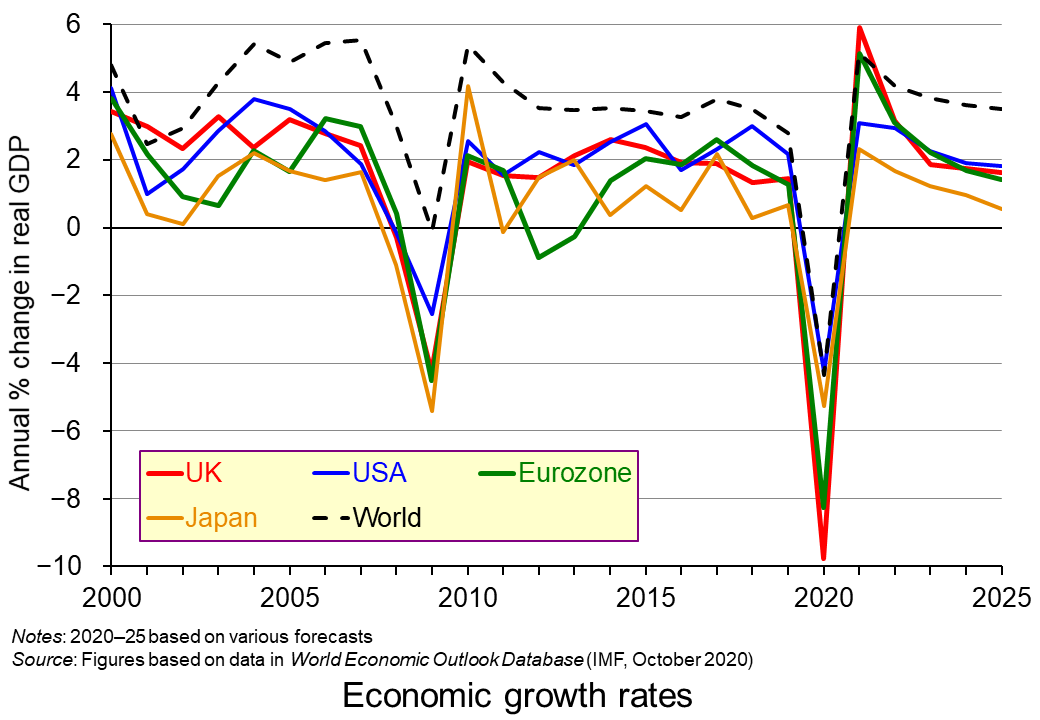 In essence the picture is similar to that painted in April. The IMF predicts a large-scale fall in GDP and rise in unemployment, government borrowing and government debt for 2020 (compared with 2019) across virtually all countries.
In essence the picture is similar to that painted in April. The IMF predicts a large-scale fall in GDP and rise in unemployment, government borrowing and government debt for 2020 (compared with 2019) across virtually all countries.
World real GDP is predicted to fall by 4.4%. For many countries the fall will be much steeper. In the UK, GDP is predicted to fall by 9.8%; in the eurozone, by 8.3%; in India, by 10.3%; in Italy, by 10.8%; in Spain, by 12.8%. 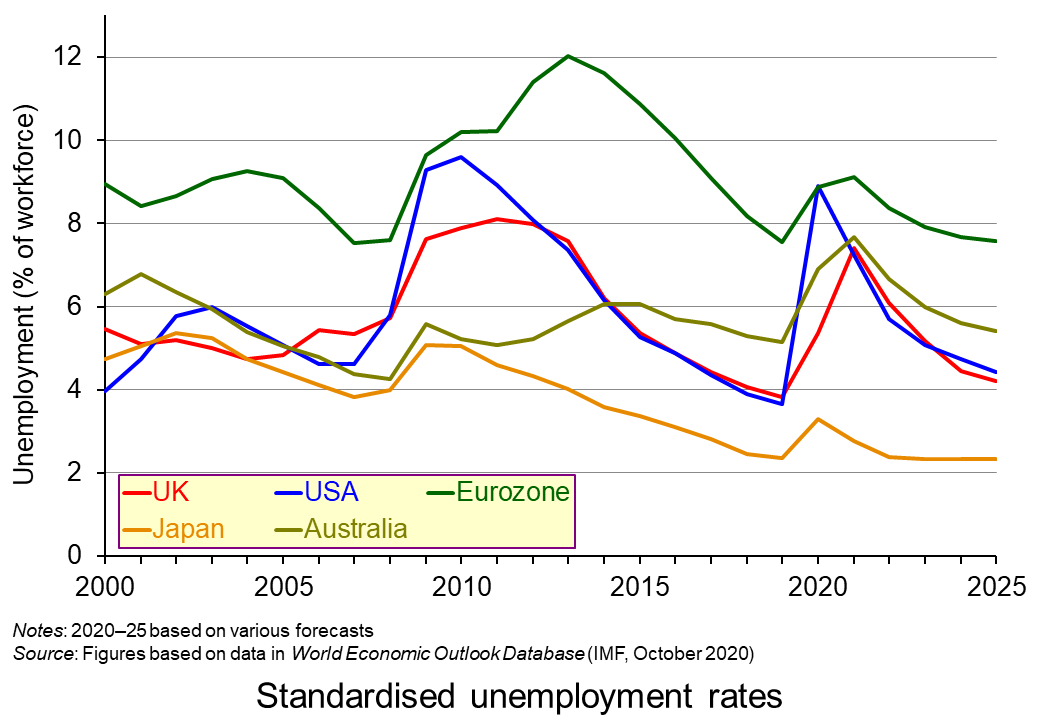 There will then be somewhat of a ‘bounce back’ in GDP in 2021, but not to the levels of 2019. World real GDP is predicted to rise by 5.2% in 2021. (Click here for a PowerPoint of the growth chart.)
There will then be somewhat of a ‘bounce back’ in GDP in 2021, but not to the levels of 2019. World real GDP is predicted to rise by 5.2% in 2021. (Click here for a PowerPoint of the growth chart.)
Unemployment will peak in some countries in 2020 and in others in 2021 depending on the speed of recovery from recession and the mobility of labour. (Click here for a PowerPoint of the unemployment chart.)
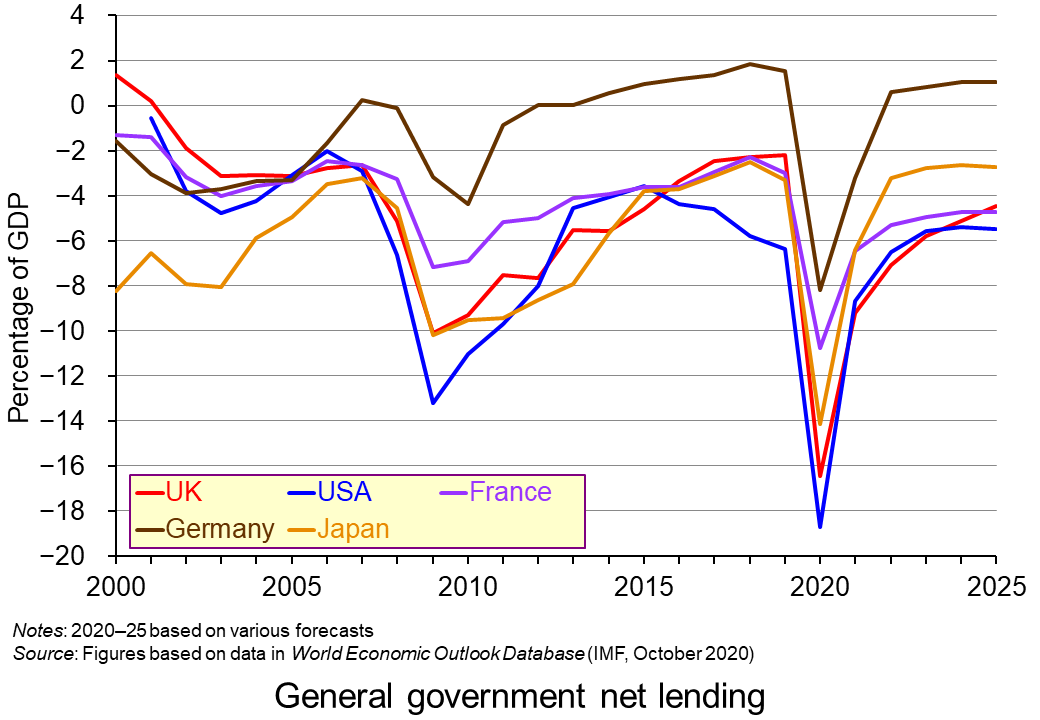 Inflation is set to fall from already low levels. Several countries are expected to see falling prices.
Inflation is set to fall from already low levels. Several countries are expected to see falling prices.
Government deficits (negative net lending) will be sharply higher in 2020 as a result of government measures to support workers and firms affected by lockdowns and falling demand. Governments will also receive reduced tax revenues. (Click here for a PowerPoint of the general government net lending chart.)
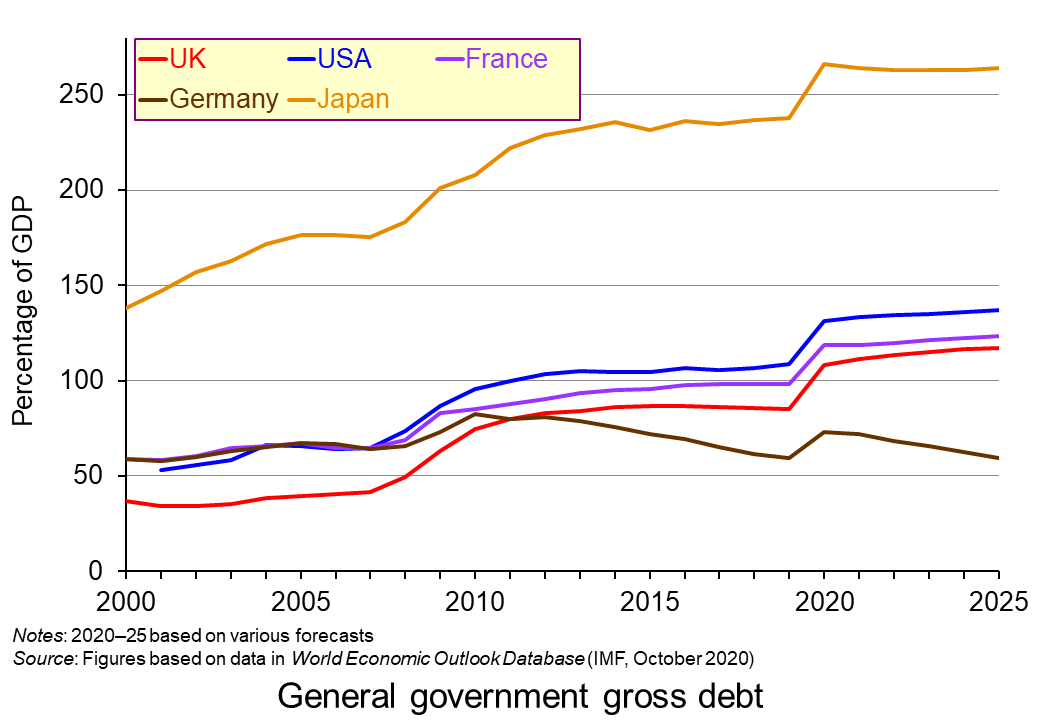 Government debt will consequently rise more rapidly. Deficits are predicted to fall in 2021 as economies recover and hence the rise in debt will slow down or in some cases, such as Germany, even fall. (Click here for a PowerPoint of the general government gross debt chart.)
Government debt will consequently rise more rapidly. Deficits are predicted to fall in 2021 as economies recover and hence the rise in debt will slow down or in some cases, such as Germany, even fall. (Click here for a PowerPoint of the general government gross debt chart.)
After the rebound in 2021, global growth is then expected to slow to around 3.5% by 2025. This compares with an average of 3.8% from 2000 to 2019. Growth of advanced economies is expected to slow to 1.7%. It averaged 1.9% from 2000 to 2019. For emerging market and developing countries it is expected to slow to 4.7% from an average of 5.7% from 2000 to 2019. These figures suggest some longer-term scarring effects from the pandemic.
Uncertainties
 In the short term, the greatest uncertainty concerns the extent of the second wave, the measures put in place to contain the spread of the virus and the compensation provided by governments to businesses and workers. The WEO report was prepared when the second wave was only just beginning. It could well be that countries will experience a deeper recession in 2000 and into 2021 than predicted by the IMF.
In the short term, the greatest uncertainty concerns the extent of the second wave, the measures put in place to contain the spread of the virus and the compensation provided by governments to businesses and workers. The WEO report was prepared when the second wave was only just beginning. It could well be that countries will experience a deeper recession in 2000 and into 2021 than predicted by the IMF.
This is recognised in the forecast.
The persistence of the shock remains uncertain and relates to factors inherently difficult to predict, including the path of the pandemic, the adjustment costs it imposes on the economy, the effectiveness of the economic policy response, and the evolution of financial sentiment.
With some businesses forced to close, others operating at reduced capacity because of social distancing in the workplace and with dampened demand, many countries may find output falling again. The extent will to a large extent depend on the levels of government support.
In the medium term, it is assumed that there will be a vaccine and that economies can begin functioning normally again. However, the report does recognise the long-term scarring effects caused by low levels of investment, deskilling and demotivation of the parts of the workforce, loss of capacity and disruptions to various supply chains.
The deep downturn this year will damage supply potential to varying degrees across economies. The impact will depend on various factors … including the extent of firm closures, exit of discouraged workers from the labour force, and resource mismatches (sectoral, occupational and geographic).
 One of the greatest uncertainties in the medium term concerns the stance of fiscal and monetary policies. Will governments continue to run large deficits to support demand or will they attempt to reduce deficits by raising taxes and/or reducing benefits and/or cutting government current or capital expenditure?
One of the greatest uncertainties in the medium term concerns the stance of fiscal and monetary policies. Will governments continue to run large deficits to support demand or will they attempt to reduce deficits by raising taxes and/or reducing benefits and/or cutting government current or capital expenditure?
Will central banks continue with large-scale quantitative easing and ultra-low or even negative interest rates? Will they use novel forms of monetary policy, such as directly funding government deficits with new money or providing money directly to citizens through a ‘helicopter’ scheme (see the 2016 blog, New UK monetary policy measures – somewhat short of the kitchen sink)?
Forecasting at the current time is fraught with uncertainty. However, reports such as the WEO are useful in identifying the various factors influencing the economy and how seriously they may impact on variables such as growth, unemployment and government deficits.
Report, speeches and data
- World Economic Outlook, October 2020: A Long and Difficult Ascent
IMF, Report (October 2020)
- World Economic Outlook Databases
IMF (October 2020)
- “We Must Take the Right Actions Now!”—Opening Remarks for Annual Meetings Press Conference
IMF, Speech, Kristalina Georgieva, IMF Managing Director (14/10/20)
 Press Briefing: World Economic Outlook
Press Briefing: World Economic OutlookIMF, Gita Gopinath, Chief Economist and Director of the Research Department, IMF; Gian Maria Milesi-Ferretti, Deputy Director, Research Department, IMF; Malhar Shyam Nabar, Division Chief, Research Department, IMF; Moderator: Raphael Anspach, Senior Communications officer, Communications Department, IMF (13/10/20)
Articles
Questions
- Explain what is meant by ‘scarring effects’. Identify various ways in which the pandemic is likely to affect aggregate supply over the longer term.
- Consider the arguments for and against governments continuing to run large budget deficits over the next few years.
- What are the arguments for and against using ‘helicopter money’ in the current circumstances?
- On purely economic grounds, what are the arguments for imposing much stricter lockdowns when Covid-19 rates are rising rapidly?
- Chose two countries other than the UK, one industrialised and one developing. Consider what policies they are pursuing to achieve an optimal balance between limiting the spread of the virus and protecting the economy.
 Latest resesarch from the independent American think tank The Conference Board paints a worrying picture about the growth of UK labour productivity. While global growth in labour productivity has weakened following the financial crisis, its weakness in the UK is singled out in the Board’s 2019 Productivity Brief. It finds that amongst large mature economies the decline in labour productivity growth rates has been greatest in the UK. This has important implications for the country’s longer-term well-being and, specifically, it peoples’ living standards.
Latest resesarch from the independent American think tank The Conference Board paints a worrying picture about the growth of UK labour productivity. While global growth in labour productivity has weakened following the financial crisis, its weakness in the UK is singled out in the Board’s 2019 Productivity Brief. It finds that amongst large mature economies the decline in labour productivity growth rates has been greatest in the UK. This has important implications for the country’s longer-term well-being and, specifically, it peoples’ living standards.
The UK saw the growth in real GDP (national output) fall from 1.8 per cent in 2017 to 1.4 per cent in 2018. The Conference Board predicts that this will fall further to 0.8 per cent in 2019. In the context of living standards, the growth in real GDP per capita is particularly important. An increase in the population will, other things being equal, lower living standards because more people will be sharing a given amount of real national income. The growth in real GDP per capita fell from 1.1 per cent in 2017 to 0.7 per cent in 2018 and is predicted to fall to just 0.1 per cent in 2019.
 Chart 1 shows the annual rates of growth in real GDP and real GDP per capita from the 1950s. The average growth rates are 2.4 and 1.9 per cent respectively. The other series shown is the annual growth in real GDP per person employed. This is a measure of the growth in labour productivity. Its average annual growth rate is also 1.9 per cent. This illustrates the intrinsic long-run relationship between labour productivity growth and the growth rate of GDP per capita and hence in general living stanadards. (Click here to download a PowerPoint copy of the chart.)
Chart 1 shows the annual rates of growth in real GDP and real GDP per capita from the 1950s. The average growth rates are 2.4 and 1.9 per cent respectively. The other series shown is the annual growth in real GDP per person employed. This is a measure of the growth in labour productivity. Its average annual growth rate is also 1.9 per cent. This illustrates the intrinsic long-run relationship between labour productivity growth and the growth rate of GDP per capita and hence in general living stanadards. (Click here to download a PowerPoint copy of the chart.)
In the short term, rates of growth in output per worker (labour productivity) and GDP per capita (general living standards) can be less similar. For example, when unemployment rates rise labour productivity rates may be little affected despite GDP per capita falling. Nonetheless, the important point here is the close long-run relationship between the growth in labour productivity and GDP per capita. This then raises an important question: what factors contribute to the growth in output and labour productivity?
An approach known as growth accounting helps to identify four key contributors to the growth of total output. The first is the quantity of labour, commonly measured in labour hours. The second is the quality of labour, also known as labour composition. Third is capital services which are physical inputs into production and include machinery, structures and IT capital. Capital services are affected by quantity and quality, but, unlike labour, it is practically more difficult to separate out these dimensions. Fourth, is Total Factor Productivity (TFP).
TFP it is essentially the residual contribution to output growth that cannot be explained by changes in the quantity and quality of the individual inputs. Hence, in principle, it is capturing changes in how effectively the labour and capital inputs are being employed and combined in production. The Conference Board’s Productivity Brief describes the growth in TFP as providing ‘a more accurate picture of the overall efficiency by which capital, labour and skills are combined in the production process’.
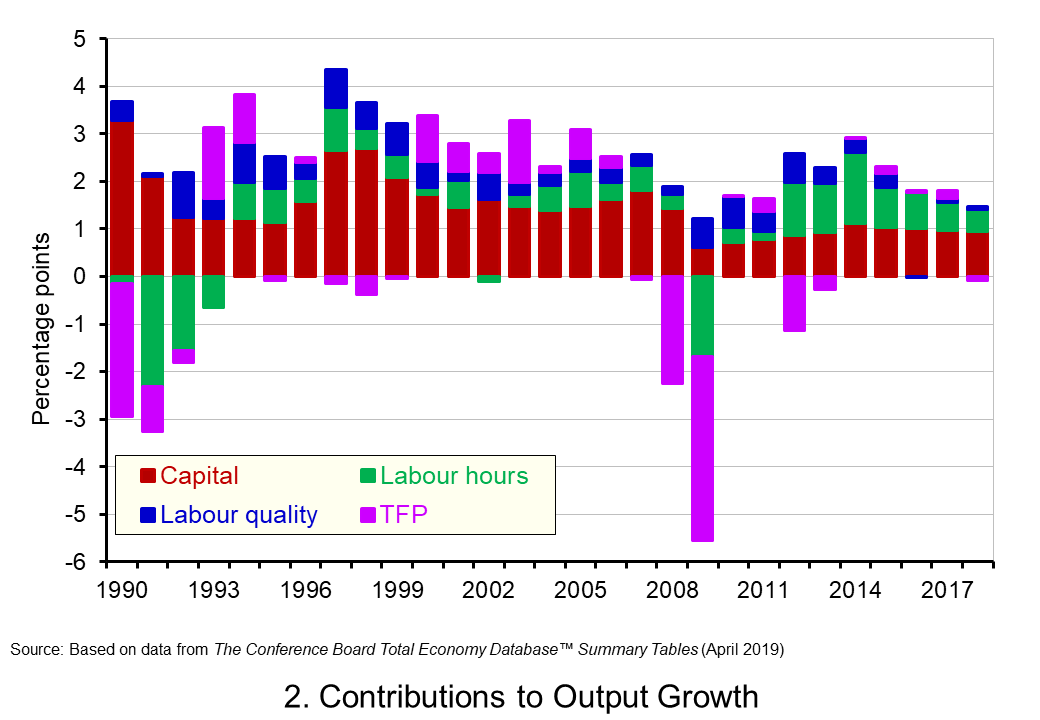 Chart 2 shows Conference Board estimates of the percentage point contribution of these four sources of growth since 1990. Over this period, output growth averaged 2 per cent per year. The contribution of capital services and, hence, what is known as capital accumulation is particularly significant at 1.5 percentage points per year. This has been significantly larger than the contribution of labour hours which averaged only 0.3 percentage points per year since 1990. This evidences the importance played by capital deepening for output growth in the UK. (Click here to download a PowerPoint copy of the chart.)
Chart 2 shows Conference Board estimates of the percentage point contribution of these four sources of growth since 1990. Over this period, output growth averaged 2 per cent per year. The contribution of capital services and, hence, what is known as capital accumulation is particularly significant at 1.5 percentage points per year. This has been significantly larger than the contribution of labour hours which averaged only 0.3 percentage points per year since 1990. This evidences the importance played by capital deepening for output growth in the UK. (Click here to download a PowerPoint copy of the chart.)
Capital deepening captures the growth in capital services relative to the growth in the labour input. It takes on even greater significance when we think about the growth in labour productivity since, after all, this is the growth in output relative to the quantity of labour. It is significant though that since 2015 the growth of capital services has contributed only 1 percentage point to output growth while the growth of labour hours has contributed an average of 0.7 percentage points. This points to a slowdown in capital deepening and hence in the growth of labour productivity.
Chart 2 also illustrates the importance of TFP growth to overall output growth. It is also important (along with capital deepening and the growth in labour quality) for the growth in labour productivity. Interestingly, we observe significant fluctuations in the growth of TFP. This is thought to reflect fluctuations in the utilisation of inputs. For example, if the utilisation of inputs falls (rises) when output falls (increases) this will be mirrored by a disproportionately large fall (increase) in TFP. In the longer-term, however, changes in TFP capture aspects of technological progress and advancement that enable more effective production methods and techniques to be deployed. In other words, the growth of TFP captures the ability of production to benefit from the advancement in ideas, products, processes and know-how.
A decline in the growth in TFP growth following the financial crisis is found quite widely in mature economies. The annual rate of growth of TFP across mature economies fell from 0.5 per cent year in 2000-2007 to 0.2 per cent in 2010-2017. In the UK this fall was from 0.5 per cent to -0.1 per cent. Hence, the decline in TFP growth of 0.6 percentage points between 2010 and 2017 was double the 0.3 percentage point fall across all mature economies. In 2018 the Conference Board estimate that TFP in the UK fell by 0.1 percent further exacerbating the downward pressure on labour productivity.
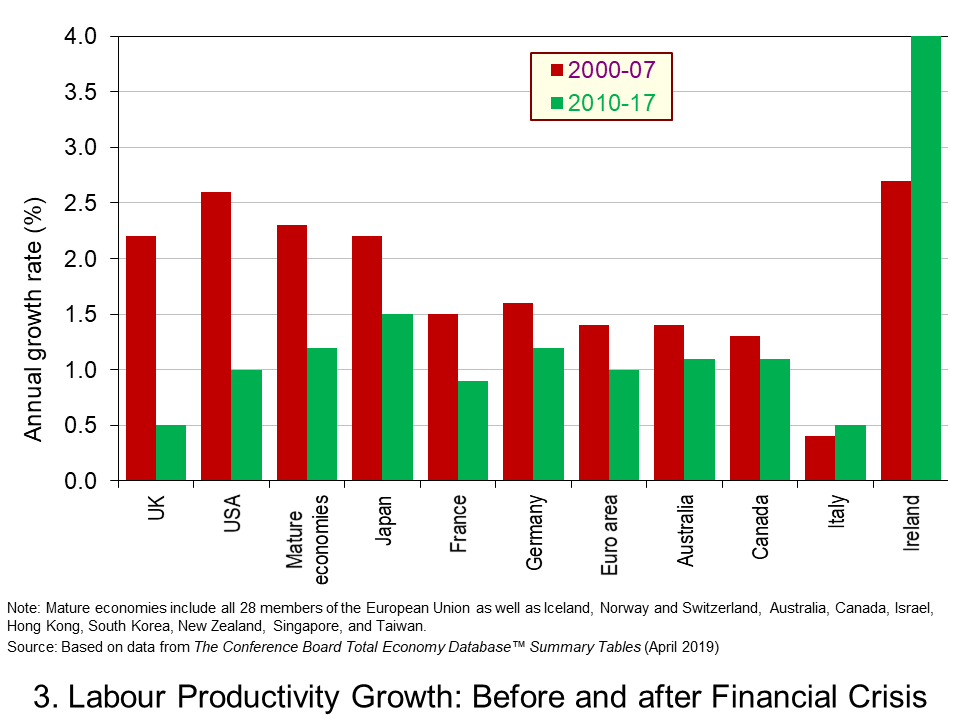 As our final chart shows, it is the magnitude to which labour productivity has eased following the financial crisis that sets the UK apart. While across all mature economies the growth of output per labour hour (another measure of labour productivity growth) fell from an average of 2.3 per cent per year in 2000-2007 to 1.2 per cent in 2010-2017, in the UK the fall was from 2.2 per cent to 0.5 per cent per year. (Click here to download a PowerPoint copy of the chart.)
As our final chart shows, it is the magnitude to which labour productivity has eased following the financial crisis that sets the UK apart. While across all mature economies the growth of output per labour hour (another measure of labour productivity growth) fell from an average of 2.3 per cent per year in 2000-2007 to 1.2 per cent in 2010-2017, in the UK the fall was from 2.2 per cent to 0.5 per cent per year. (Click here to download a PowerPoint copy of the chart.)
While the productivity problem facing the UK is not new, the latest figures comes as a very timely reminder of the extent of the problem. To some extent the uncertainty around Brexit and the negative impact on capital accumulation has only helped to exacerbate the problem. But, this may mask a more systemic problem facing the UK. Getting to the root of this problem matters. It matters most significantly for our long-term wellbeing and prosperity. The productivity gap with our major industrial competitors is a gap that policymakers need not only to be mindful of but one that needs closing.
Articles
Questions
- What do you understand by the term labour productivity. How could we measure it?
- Why is it important to look at the growth of output per capita when assessing the benefits of long-term growth?
- Why is labour productivity important for the long-term well-being of a country?
- What do you understand by the method of growth accounting?
- What is the distinction between capital accumulation and capital deepening?
- What might explain why the growth of labour productivity has been lower in the years following the post-financial crisis?
- What do you understand by Total Factor Productivity (TFP)?
- What does the long-term growth of TFP attempt to capture?
- If you were an economic advisor to the government, what types of policy initiatives might you recommend for a government concerned about low rates of growth of labour productivity?

 Governments can incentivise individuals and firms through emissions and product taxes, through carbon pricing, through cap-and-trade schemes, through subsidies on green investment, production and consumption, through legal limits on emissions, through trying to change behaviour by education campaigns, and so on. In each case, the extent to which individuals and firms will respond is hard to predict. People may want to reduce global warming and yet be reluctant to change their own behaviour, seeing themselves as too insignificant to make any difference and blaming big business, governments or rich individuals. It is important, therefore, for governments to get incentive mechanisms right to achieve the stated targets.
Governments can incentivise individuals and firms through emissions and product taxes, through carbon pricing, through cap-and-trade schemes, through subsidies on green investment, production and consumption, through legal limits on emissions, through trying to change behaviour by education campaigns, and so on. In each case, the extent to which individuals and firms will respond is hard to predict. People may want to reduce global warming and yet be reluctant to change their own behaviour, seeing themselves as too insignificant to make any difference and blaming big business, governments or rich individuals. It is important, therefore, for governments to get incentive mechanisms right to achieve the stated targets. The chart shows the 15 countries providing the largest amount of support to fossil fuel industries in 2020 (in 2021 prices). The bars are in billions of dollars and the percentage of GDP is also given for each country. Subsidies include both production and consumption subsidies. (Click here for a PowerPoint of the chart.) In addition to the direct subsidies shown in the chart, there are the indirect costs of subsidies, including pollution, environmental destruction and the impact on the climate. According to the IMF, these amounted to $5.4 trillion in 2020.
The chart shows the 15 countries providing the largest amount of support to fossil fuel industries in 2020 (in 2021 prices). The bars are in billions of dollars and the percentage of GDP is also given for each country. Subsidies include both production and consumption subsidies. (Click here for a PowerPoint of the chart.) In addition to the direct subsidies shown in the chart, there are the indirect costs of subsidies, including pollution, environmental destruction and the impact on the climate. According to the IMF, these amounted to $5.4 trillion in 2020. The first draft of the conference agreement called for countries to ‘to accelerate the phasing-out of coal and subsidies for fossil fuels’. But, after objections from major coal producing countries, such as China, India and Australia, this was weakened to calling on countries to accelerate the shift to clean energy systems ‘by scaling up the deployment of clean power generation and energy efficiency measures, including accelerating efforts towards the phasedown of unabated coal power and phase-out of inefficient fossil fuel subsidies’. (‘Unabated’ coal power refers to power generation with no carbon capture.) Changing ‘phasing-out’ to ‘the phasedown’ caused consternation among many delegates who saw this as a substantial weakening of the drive to end the use of coal.
The first draft of the conference agreement called for countries to ‘to accelerate the phasing-out of coal and subsidies for fossil fuels’. But, after objections from major coal producing countries, such as China, India and Australia, this was weakened to calling on countries to accelerate the shift to clean energy systems ‘by scaling up the deployment of clean power generation and energy efficiency measures, including accelerating efforts towards the phasedown of unabated coal power and phase-out of inefficient fossil fuel subsidies’. (‘Unabated’ coal power refers to power generation with no carbon capture.) Changing ‘phasing-out’ to ‘the phasedown’ caused consternation among many delegates who saw this as a substantial weakening of the drive to end the use of coal.  Transitioning to a low-carbon economy and investing in measures to protect people from rising sea levels, floods, droughts, fires, etc. costs money. With many developing countries facing serious financial problems, especially in the light of measures to support their economies and healthcare systems to mitigate the effects of COVID-19, support is needed from the developed world.
Transitioning to a low-carbon economy and investing in measures to protect people from rising sea levels, floods, droughts, fires, etc. costs money. With many developing countries facing serious financial problems, especially in the light of measures to support their economies and healthcare systems to mitigate the effects of COVID-19, support is needed from the developed world. Again, more than 100 countries agreed to stop deforestation by 2030. These countries include Indonesia and Brazil, which has been heavily criticised for allowing large parts of the Amazon rainforest to be cleared for farming, such that the Amazon region in recent years has been a net emitter of carbon from the felling and burning of trees. The pledge has been met with considerable cynicism, however, as it unclear how it will be policed. Much of the deforestation around the world is already illegal but goes ahead anyway.
Again, more than 100 countries agreed to stop deforestation by 2030. These countries include Indonesia and Brazil, which has been heavily criticised for allowing large parts of the Amazon rainforest to be cleared for farming, such that the Amazon region in recent years has been a net emitter of carbon from the felling and burning of trees. The pledge has been met with considerable cynicism, however, as it unclear how it will be policed. Much of the deforestation around the world is already illegal but goes ahead anyway. Blah, blah, blah or real action?
Blah, blah, blah or real action? What’s in the COP26 deal – and will it save humanity?
What’s in the COP26 deal – and will it save humanity? Cop26: where does the world go from here?
Cop26: where does the world go from here? What is net zero?
What is net zero? Ros Atkins On: The Challenge of Net Zero
Ros Atkins On: The Challenge of Net Zero What is carbon trading?
What is carbon trading? One of the major economic concerns about the COVID-19 pandemic has been the likely long-term scarring effects on economies from bankruptcies, a decline in investment, lower spending on research and development, a loss of skills, discouragement of workers, disruption to education, etc. The result would be a decline in potential output or, at best, a slower growth. These persistent effects are known as ‘hysteresis’ – an effect that persists after the original cause has disappeared.
One of the major economic concerns about the COVID-19 pandemic has been the likely long-term scarring effects on economies from bankruptcies, a decline in investment, lower spending on research and development, a loss of skills, discouragement of workers, disruption to education, etc. The result would be a decline in potential output or, at best, a slower growth. These persistent effects are known as ‘hysteresis’ – an effect that persists after the original cause has disappeared.  The first is that the pandemic may have hastened the process of digitalisation and automation. Examples include ‘video conferencing and file sharing applications to drones and data-mining technologies’. According to evidence from a sample of 15 countries cited in the blog, a 10% rise in such intangible capital investment is associated with about a 4½% rise in labour productivity. ‘As COVID-19 recedes, the firms which invested in intangible assets, such as digital technologies and patents may see higher productivity as a result.’
The first is that the pandemic may have hastened the process of digitalisation and automation. Examples include ‘video conferencing and file sharing applications to drones and data-mining technologies’. According to evidence from a sample of 15 countries cited in the blog, a 10% rise in such intangible capital investment is associated with about a 4½% rise in labour productivity. ‘As COVID-19 recedes, the firms which invested in intangible assets, such as digital technologies and patents may see higher productivity as a result.’ Many developing countries are facing a renewed debt crisis. This is directly related to Covid-19, which is now sweeping across many poor countries in a new wave.
Many developing countries are facing a renewed debt crisis. This is directly related to Covid-19, which is now sweeping across many poor countries in a new wave.  International agencies and groups, such as the IMF, the World Bank, the United Nations and the G20, have all advocated increased help to tackle this debt crisis. The IMF has allocated $100bn in lending through the Rapid Financing Instrument (
International agencies and groups, such as the IMF, the World Bank, the United Nations and the G20, have all advocated increased help to tackle this debt crisis. The IMF has allocated $100bn in lending through the Rapid Financing Instrument ( The G20 countries, with the support of the IMF and World Bank, have committed to suspend debt service payments by eligible countries which request to participate in its Debt Service Suspension Initiative (
The G20 countries, with the support of the IMF and World Bank, have committed to suspend debt service payments by eligible countries which request to participate in its Debt Service Suspension Initiative ( In essence the picture is similar to that painted in April. The IMF predicts a large-scale fall in GDP and rise in unemployment, government borrowing and government debt for 2020 (compared with 2019) across virtually all countries.
In essence the picture is similar to that painted in April. The IMF predicts a large-scale fall in GDP and rise in unemployment, government borrowing and government debt for 2020 (compared with 2019) across virtually all countries.  There will then be somewhat of a ‘bounce back’ in GDP in 2021, but not to the levels of 2019. World real GDP is predicted to rise by 5.2% in 2021. (Click
There will then be somewhat of a ‘bounce back’ in GDP in 2021, but not to the levels of 2019. World real GDP is predicted to rise by 5.2% in 2021. (Click  Inflation is set to fall from already low levels. Several countries are expected to see falling prices.
Inflation is set to fall from already low levels. Several countries are expected to see falling prices.  Government debt will consequently rise more rapidly. Deficits are predicted to fall in 2021 as economies recover and hence the rise in debt will slow down or in some cases, such as Germany, even fall. (Click
Government debt will consequently rise more rapidly. Deficits are predicted to fall in 2021 as economies recover and hence the rise in debt will slow down or in some cases, such as Germany, even fall. (Click  In the short term, the greatest uncertainty concerns the extent of the second wave, the measures put in place to contain the spread of the virus and the compensation provided by governments to businesses and workers. The WEO report was prepared when the second wave was only just beginning. It could well be that countries will experience a deeper recession in 2000 and into 2021 than predicted by the IMF.
In the short term, the greatest uncertainty concerns the extent of the second wave, the measures put in place to contain the spread of the virus and the compensation provided by governments to businesses and workers. The WEO report was prepared when the second wave was only just beginning. It could well be that countries will experience a deeper recession in 2000 and into 2021 than predicted by the IMF. One of the greatest uncertainties in the medium term concerns the stance of fiscal and monetary policies. Will governments continue to run large deficits to support demand or will they attempt to reduce deficits by raising taxes and/or reducing benefits and/or cutting government current or capital expenditure?
One of the greatest uncertainties in the medium term concerns the stance of fiscal and monetary policies. Will governments continue to run large deficits to support demand or will they attempt to reduce deficits by raising taxes and/or reducing benefits and/or cutting government current or capital expenditure? 
 Chart 1 shows the annual rates of growth in real GDP and real GDP per capita from the 1950s. The average growth rates are 2.4 and 1.9 per cent respectively. The other series shown is the annual growth in real GDP per person employed. This is a measure of the growth in labour productivity. Its average annual growth rate is also 1.9 per cent. This illustrates the intrinsic long-run relationship between labour productivity growth and the growth rate of GDP per capita and hence in general living stanadards. (Click
Chart 1 shows the annual rates of growth in real GDP and real GDP per capita from the 1950s. The average growth rates are 2.4 and 1.9 per cent respectively. The other series shown is the annual growth in real GDP per person employed. This is a measure of the growth in labour productivity. Its average annual growth rate is also 1.9 per cent. This illustrates the intrinsic long-run relationship between labour productivity growth and the growth rate of GDP per capita and hence in general living stanadards. (Click  Chart 2 shows Conference Board estimates of the percentage point contribution of these four sources of growth since 1990. Over this period, output growth averaged 2 per cent per year. The contribution of capital services and, hence, what is known as capital accumulation is particularly significant at 1.5 percentage points per year. This has been significantly larger than the contribution of labour hours which averaged only 0.3 percentage points per year since 1990. This evidences the importance played by capital deepening for output growth in the UK. (Click
Chart 2 shows Conference Board estimates of the percentage point contribution of these four sources of growth since 1990. Over this period, output growth averaged 2 per cent per year. The contribution of capital services and, hence, what is known as capital accumulation is particularly significant at 1.5 percentage points per year. This has been significantly larger than the contribution of labour hours which averaged only 0.3 percentage points per year since 1990. This evidences the importance played by capital deepening for output growth in the UK. (Click  As our final chart shows, it is the magnitude to which labour productivity has eased following the financial crisis that sets the UK apart. While across all mature economies the growth of output per labour hour (another measure of labour productivity growth) fell from an average of 2.3 per cent per year in 2000-2007 to 1.2 per cent in 2010-2017, in the UK the fall was from 2.2 per cent to 0.5 per cent per year. (Click
As our final chart shows, it is the magnitude to which labour productivity has eased following the financial crisis that sets the UK apart. While across all mature economies the growth of output per labour hour (another measure of labour productivity growth) fell from an average of 2.3 per cent per year in 2000-2007 to 1.2 per cent in 2010-2017, in the UK the fall was from 2.2 per cent to 0.5 per cent per year. (Click